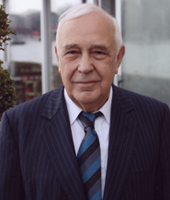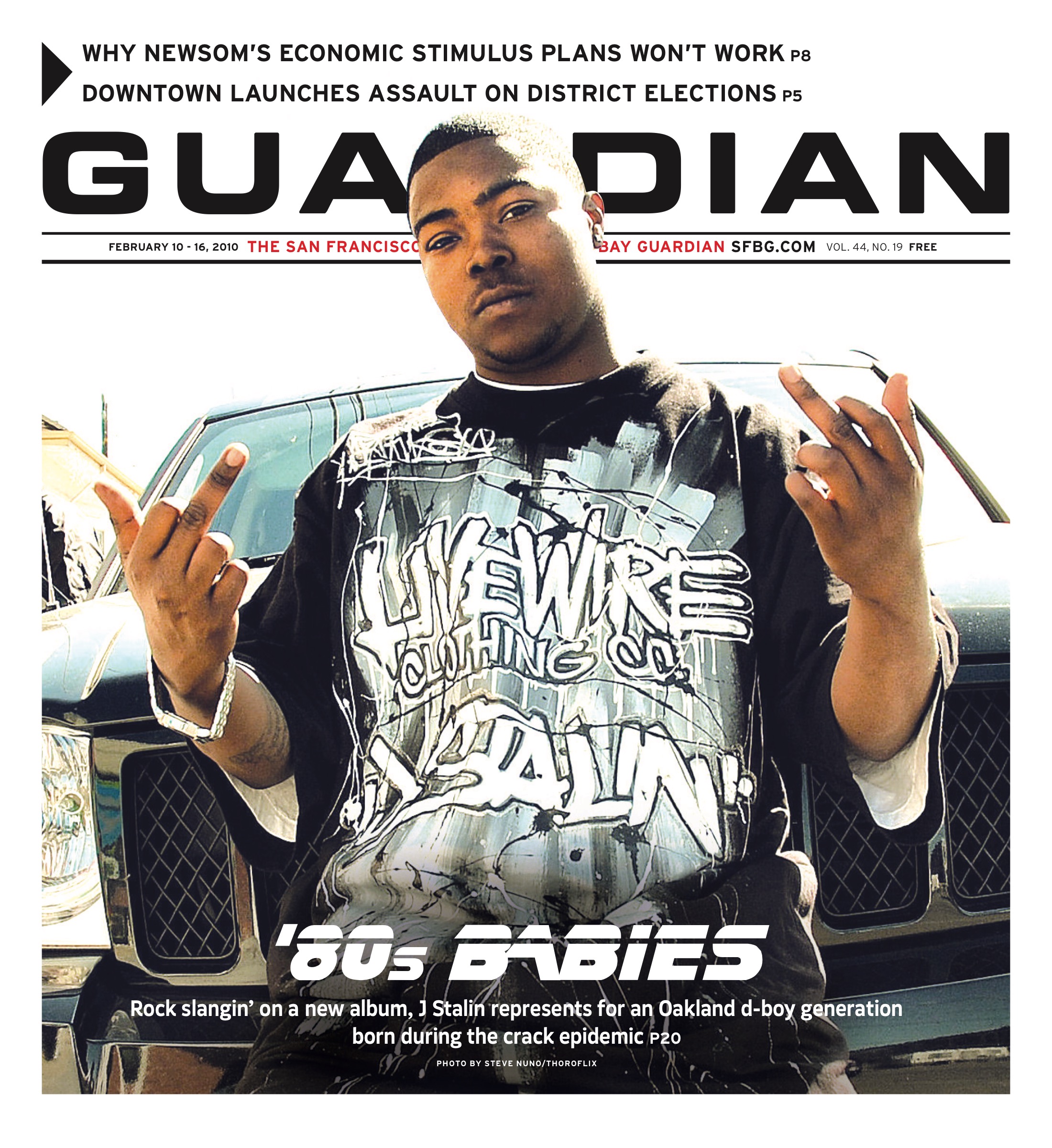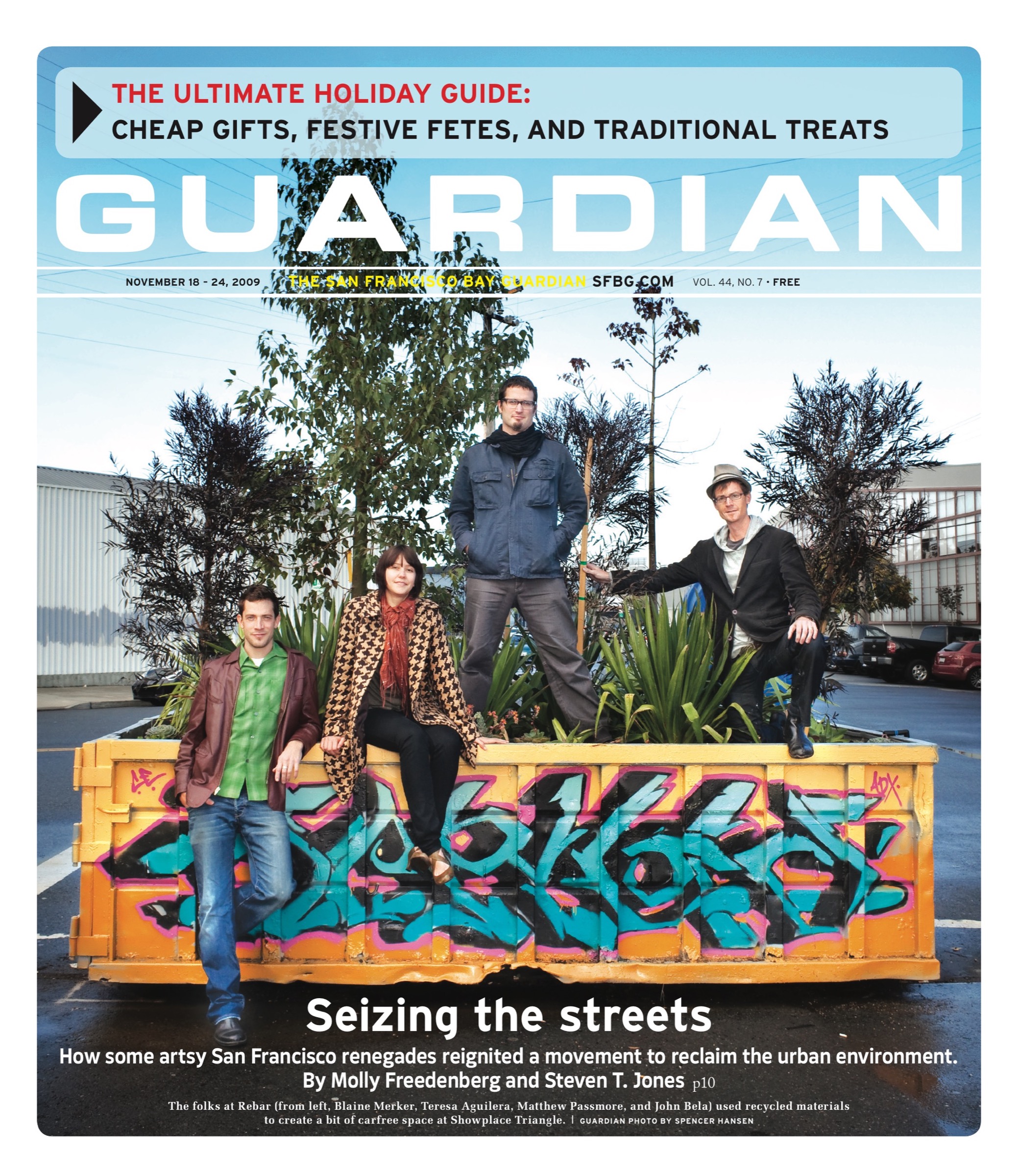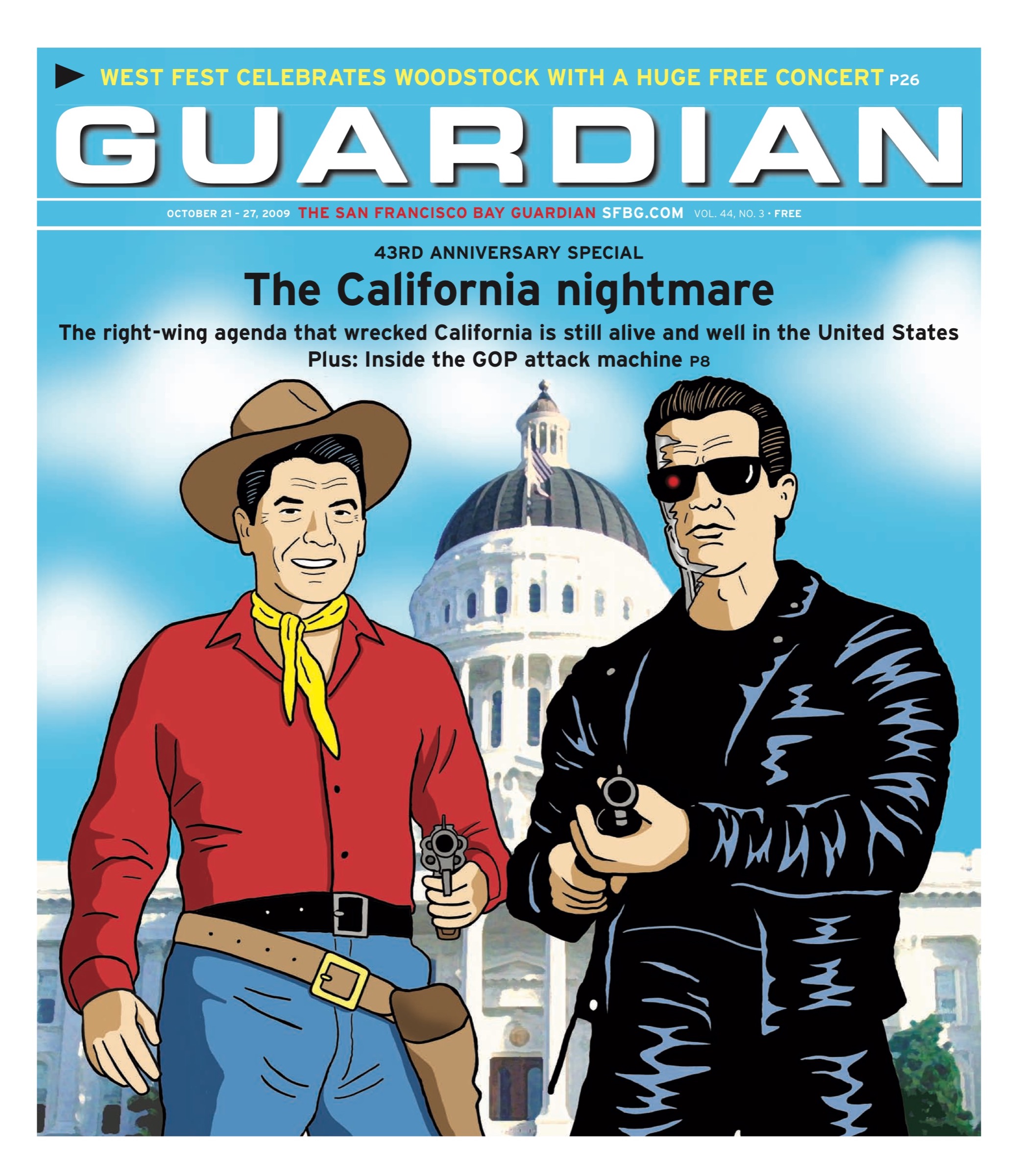Music listings are compiled by Paula Connelly and Cheryl Eddy. Since club life is unpredictable, it’s a good idea to call ahead to confirm bookings and hours. Prices are listed when provided to us. Submit items at listings@sfbg.com. For further information on how to submit items for the listings, see Picks.
WEDNESDAY 18
ROCK/BLUES/HIP-HOP
Actionslacks, Love is Chemicals, Ex-Boyfriends Bottom of the Hill. 9pm, $8.
Cheetahs on the Moon, Bodice Rippers, Sugarbutt Tiger Annie’s Social Club. 9pm, $6.
Collisionville, Control-R, Pomegranate El Rio. 8pm, $5.
Comeback Kid, Gravemaker, Mother of Mercy, Dead Swan Thee Parkside. 8pm, $12.
Confunkshun Rrazz Room, Hotel Nikko, 222 Mason, SF; 1-888-468-3399. 8pm, $30-35.
Elm, Midday Veil, Sequin Trails Hemlock. 9pm, $6.
Frail, Lleggs Harlot, 46 Minna, SF; (415) 777-1077. 9pm, $5.
Joe Krown Trio Biscuits and Blues. 8pm, $18.
*Judgement Day, La Fin du Monde, Grayceon Annie’s Social Club. 8:30pm, $7.
*King Khan and BBQ Show, Those Darlins Independent. 8pm, $15.
Nitzer Ebb, King Loses Crown Slim’s. 8pm, $25.
Chris Pierce, Amber Rubarth, Corb Lund Hotel Utah. 8:30pm, $10.
Julian Plenti, I’m in You Great American Music Hall. 8pm, $16.
Saints of Ruin Red Devil Lounge. 8pm, $8-10.
Society of Rockets, Conspiracy of Beards, Lotus Feet Elbo Room. 9pm, $7.
BAY AREA
Raphael Saadiq, Anjulie, Melanie Fiona Fox Theater. 7:30pm, $39.50.
JAZZ/NEW MUSIC
Ben Marcato and the Mondo Combo Top of the Mark. 7:30pm, $10.
Marcus Shelby Jazz Jam Revolution Café, 3248 22nd St, SF; (415) 642-0474. 8:45pm, free.
Michael Browne Trio Rite Spot, 2099 Folsom, SF; (415) 552-6066. 9pm, free.
Cat’s Corner Savanna Jazz. 7pm, $5-10.
Shana Morrison Yoshi’s San Francisco. 8pm, $14.
Tamika Nicole Yoshi’s San Francisco. 10:30pm, $14.
Tin Cup Serenade Le Colonial, 20 Cosmo Place, SF; (415) 931-3600. 7pm, free.
FOLK/WORLD/COUNTRY
Freddy Clarke, Wobbly World Peña Pachamama, 1630 Powell, SF; (415) 646-0018. 8:30, $10.
Gaucho, Michael Abraham Jazz Session Amnesia. 8pm, free.
Leigh Gregory Plough and Stars. 9pm.
Erin McKeown, Sonya Kitchell Café du Nord. 8:30pm, $15.
Amber Rubarth Hotel Utah. 8pm, $10-12.
DANCE CLUBS
Booty Call Q-Bar, 456 Castro; www.bootycallwednesdays.com. 9pm. Juanita Moore hosts this dance party, featuring DJ Robot Hustle.
Hands Down! Bar on Church. 9pm, free. With DJs Claksaarb, Mykill, and guests spinning indie, electro, house, and bangers.
Jam Wednesday Infusion Lounge. 10pm, free. DJ Slick Dee.
Qoöl 111 Minna Gallery. 5-10pm, $5. Pan-techno lounge with DJs Spesh, Gil, Hyper D, and Jondi.
RedWine Social Dalva. 9pm-2am, free. DJ TophOne and guests spin outernational funk and get drunk.
Respect Wednesdays End Up. 10pm, $5. Rotating DJs Daddy Rolo, Young Fyah, Irie Dole, I-Vier, Sake One, Serg, and more spinning reggae, dancehall, roots, lovers rock, and mash ups.
Synchronize Il Pirata, 2007 16th St.; (415) 626-2626. 10pm, free. Psychedelic dance music with DJs Helios, Gatto Matto, Psy Lotus, Intergalactoid, and guests.
THURSDAY 19
ROCK/BLUES/HIP-HOP
Chris Brown Fillmore. 7pm, $38.50.
Confunkshun Rrazz Room, Hotel Nikko, 222 Mason, SF; 1-888-468-3399. 8pm, $30-35.
*Ensiferum, Hypocrisy, Blackguard DNA Lounge. 8pm, $22.
Hidden Cameras, Gentleman Reg, Winter’s Fall Bottom of the Hill. 9pm, $14.
Kevin Russell Trio Biscuits and Blues. 8pm, $15.
Meta, Ana Lucia, Burnt Thumbs El Rio. 9pm, $6.
Microfiche, Elle Nino, Camp Out, Hey Young Believer Hotel Utah. 9pm, $6.
Neon Indian, Love X Nowhere Rickshaw Stop. 8pm, $10-12.
Peter Bjorn and John, El Perro Del Mer Great American Music Hall. 9pm, $23.
Railcars, Samuelroy, Pregnant, Felt Drawings Thee Parkside. 9pm, $6.
Röyksopp, Jon Hopkins Regency Ballroom. 8pm, $32.
Silian Rail, Grand Lake, Ash Reiter Hemlock Tavern. 9pm, $7.
Tainted Love Red Devil Lounge. 8pm, $15.
0th, Kurione, Paper Legs, William Winat, Weasle Walter, and John Gruntfest Trio Amnesia. 9pm, $6.
BAY AREA
Them Crooked Vultures, Mini Mansions Fox Theater. 8pm, $49.50.
JAZZ/NEW MUSIC
Joe Bagale, Crystal Monee Hall Yoshi’s San Francisco. 10:30pm, $10.
Margie Baker Shanghai 1930. 7pm, free.
Al Coster Trio and jam session Savanna Jazz. 8pm, $5.
Terry Disley Washington Square Bar and Grill, 1707 Powell, SF; (415) 433-1188. 7pm, free.
Eric Kurtzrock Trio Ana Mandara, Ghirardelli Square, 891 Beach, SF; (415) 771-6800. 7:30pm, free.
Laurent Fourgo Le Colonial, 20 Cosmo Place, SF; (415) 931-3600. 7:30pm, free.
Marlina Teich Trio Brickhouse, 426 Brannan, SF; (415) 820-1595. 7-10pm, free.
Stephen Merriman Simple Pleasures, 3434 Balboa, SF; (415) 387-4022. 8pm, free.
Stompy Jones Top of the Mark. 7:30pm, $10.
FOLK/WORLD/COUNTRY
Battlin’ Blue Birds Dolores Park Café. 7:30pm, free.
Bluegrass Old Time Jam Atlas Café. 8pm, free.
Classical Revolution Amnesia. 6pm, free.
Frisky Frolics Rite Spot, 2099 Folsom, SF; (415) 552-6066. 9pm, free.
Jim Lauderdale Noe Valley Ministry, 1021 Sanchez, SF; (415) 454-5238. 8:15pm, $22.
Jueves Flamencos Peña Pachamama, 1630 Powell, SF; (415) 646-0018. 8:15pm, $10; 9:30pm, $12.
Mission 3 Revolution Café, 3248 22nd St, SF; (415) 642-0474. 8:45pm, free.
Tipsy House Plough and Stars. 9pm.
Worried Minds Socha Café, 3235 Mission, SF; (415) 643-6848. 8:30pm.
DANCE CLUBS
Afrolicious Elbo Room. 9:30pm, $5-6. DJs Pleasuremaker, Señor Oz, J Elrod, B Lee, and special guest Beto spin Afrobeat, Tropicália, electro, samba, and funk featuring an album listening party for Tito Rodriguez.
Bingotopia Knockout. 7:30-9:30pm, free. Play for drinks, dignity, and dorky prizes with Lady Stacy Pants.
Caribbean Connection Little Baobab, 3388 19th St; 643-3558. 10pm, $3. DJ Stevie B and guests spin reggae, soca, zouk, reggaetón, and more.
Club Jammies Edinburgh Castle. 10pm, free. DJs EBERrad and White Mice spinning reggae, punk, dub, and post punk.
Drop the Pressure Underground SF. 6-10pm, free. Electro, house, and datafunk highlight this weekly happy hour.
Echo-A-Gogo Knockout. 10pm, free. Vintage dub reggae with DJ Lucky and friends.
Funky Rewind Skylark. 9pm, free. DJ Kung Fu Chris, MAKossa, and rotating guest DJs spin heavy funk breaks, early hip-hop, boogie, and classic Jamaican riddims.
Heat Icon Ultra Lounge. 10pm, free. Hip-hop, R&B, reggae, and soul.
Kick It Bar on Church. 9pm. Hip-hop with DJ Jorge Terez.
Koko Puffs Koko Cocktails, 1060 Geary; 885-4788. 10pm, free. Dubby roots reggae and Jamaican funk from rotating DJs.
Mestiza Bollywood Café, 3376 19th St., SF; (415) 970-0362. 10pm, free. Showcasing progressive Latin and global beats with DJ Juan Data.
Popscene 330 Rich. 10pm, $10. Rotating DJs spinning indie, Britpop, electro, new wave, and post-punk.
Represent Icon Lounge. 10pm, $5. With Resident DJ Ren the Vinyl Archaeologist and guest. Rock Candy Stud. 9pm-2am, $5. Luscious Lucy Lipps hosts this electro-punk-pop party with music by ReXick.
Solid Club Six. 9pm, $5. With resident DJ Daddy Rolo and rotating DJs Mpenzi, Shortkut, Polo Mo’qz and Fuze spinning roots, reggae, and dancehall.
FRIDAY 20
ROCK/BLUES/HIP-HOP
Billy and Dolly with Tell-Tale Hearts, Michael Zapruder, Paul Bertolino Hotel Utah. 9pm, $10.
Confunkshun Rrazz Room, Hotel Nikko, 222 Mason, SF; 1-888-468-3399. 7 and 9:30pm, $30-35.
Disco Biscuits Fillmore. 9pm, $25.
Dolorata, Audrey Howard and the Misters, View from Space Bottom of the Hill. 10pm, $10.
*El Dopa, Cretaceous Annie’s Social Club. 9:30pm, $8.
Eternal Tapestry, Barn Owl, Moon Duo, Real Estate Hemlock Tavern. 9pm, $8.
Fiery Furnaces, Cryptacize, Dent May Slim’s. 9pm, $16.
Girls Swedish American Hall (upstairs from Café du Nord). 8pm, $15.
Houston Jones Noe Valley Ministry, 1021 Sanchez, SF; (415) 454-5238. 8:15pm, $19.
DJ Lebowitz Madrone Art Bar. 6-9pm, free.
*McCabe and Mrs. Miller, Paul and John Make-Out Room. 7pm, $7.
New Thrill Parade, Tape Deck Mountain, Red Pony Clock, Monnone Alone, Borneo Amnesia. 9pm, $8.
Peter Bjorn and John, El Perro Del Mer Great American Music Hall. 9pm, $23.
Sleepytime Gorilla Museum, Faun Fables Independent. 9pm, $18.
Earl Thomas and the Blues Ambassadors Biscuits and Blues. 8 and 10pm, $22.
Zoo Station Red Devil Lounge. 8pm, $10.
JAZZ/NEW MUSIC
Audium 9 1616 Bush, SF; (415) 771-1616. 8:30pm, $15.
Patti Austin Yoshi’s San Francisco. 8 and 10pm, $30-38.
Black Market Jazz Orchestra Top of the Mark. 9pm, $10.
Bryan Girard Quartet Cliff House Restaurant, 1090 Point Lobos, SF; (415) 386-3330. 7pm, free.
Stephanie Crawford Savanna Jazz. 8pm, $8.
Eric Kurtzrock Trio Ana Mandara, Ghirardelli Square, 891 Beach, SF; (415) 771-6800. 8pm, free.
Lucid Lovers Rex Hotel, 562 Sutter, SF; (415) 433-4434. 6-8pm.
T.D. Skatchit and Company Community Music Center, 544 Capp, SF; (415) 647-6015. 8pm, $10.
Terry Disley Experience Shanghai 1930. 7:30pm, free.
FOLK/WORLD/COUNTRY
Seth Augustus Revolution Café, 3248 22nd St, SF; (415) 642-0474. 8:45pm, free.
Andrew Skewes Cox Socha Café, 3235 Mission, SF; (415) 643-6848. 8:30pm.
Toshio Hirano Mercury Café, 201 Octavia, SF; (415) 252-7855. 7:30pm, free.
Forro in the Dark, Nneka, DJ Felina Café du Nord. 9:30pm, $12-15.
49 Special Plough and Stars. 9pm, $6-10 sliding scale.
International Studies Academy (ISA) Concert Dolores Park Café. 7:30pm, free.
Rob Reich and Craig Ventresco Amnesia. 7pm, free.
Rolando Morales and group Peña Pachamama, 1630 Powell, SF; (415) 646-0018. 8pm, 10pm.
Samba Da Elbo Room. 10pm, $15.
Lee Vilenski Rite Spot, 2099 Folsom, SF; (415) 552-6066. 9pm, free.
DANCE CLUBS
Activate! Lookout, 3600 16th St; (415) 431-0306. 9pm, $3. Face your demigods and demons at this Red Bull-fueled party.
Bar on Church 9pm. Rotating DJs Zax, Zhaldee, and Nuxx.
Blow Up Rickshaw Stop. 10pm, $15. With DJs Jeffrey Paradise and Richie Panic spinning dance music.
Conspirator 103 Harriet, 103 Harriet, SF; (415) 431-3609. 10pm, $20. Disco Biscuits after party.
Deep Fried Butter, 354 11th St., SF; (415) 863-5964. DJs jaybee, David Justin, and Dean Manning spinning indie, dance rock, electronica, funk, hip hop, and more.
Exhale, Fridays Project One Gallery, 251 Rhode Island; (415) 465-2129. 5pm, $5. Happy hour with art, fine food, and music with Vin Sol, King Most, DJ Centipede, and Shane King.
Fat Stack Fridays Koko Cocktails, 1060 Geary, SF; (415) 885-4788. 10pm, free. With rotating DJs Romanowski, B-Love, Tomas, Toph One, and Vinnie Esparza.
510’s Finest Presents: King Thee Parkside. 10pm, $4.
Gay Asian Paradise Club Eight, 1151 Folsom, SF; www.eightsf.com. 9pm, $8. Featuring two dance floors playing dance and hip hop, smoking patio, and 2 for 1 drinks before 10pm.
House of Voodoo Medici Lounge, 299 9th St., SF; (415) 501-9162. 9pm, $5. With DJs Voodoo, Purgatory, and more spinning goth, industrial, deathrock, and glam.
Look Out Weekend Bambuddha Lounge. 4pm, free. Drink specials, food menu and resident DJs White Girl Lust, Swayzee, Philie Ocean, and more.
Loose Stud. 10pm-3am, $5. DJs Domino and Six spin electro and indie, with vintage porn visual projections to get you in the mood.
M4M Fridays Underground SF. 10pm-2am. Joshua J and Frankie Sharp host this man-tastic party.
Juan Maclean DJ Set (Tribute to Gerhardt Fuchs), Parallels, DJs Eug and J. Montag Mezzanine. 9pm, $13.
Oldies Night Knockout. 9pm, $2-4. Doo-wop, one-hit wonders, and soul with DJs Primo, Daniel, and Lost Cat.
Pirate Cat Radio Benefit Triple Crown. 8pm, $10. Proceeds to help pay recent fines imposed by the FCC.
Punk Rock and Shlock Karaoke Annie’s Social Club. 9pm-2am, $5. Eileen and Jody bring you songs from multiple genres to butcher: punk, new wave, alternative, classic rock, and more.
The Present Club Six. 9pm, $15. Featuring performances by Luckyiam PSC, The Bayliens, Wordplay, and more with DJs Franky Fresh, Beast, and more spinning hip hop.
SATURDAY 21
ROCK/BLUES/HIP-HOP
"A&R Live: Major Label Showcase" Thee Parkside. 9pm, $15.
Confunkshun Rrazz Room, Hotel Nikko, 222 Mason, SF; 1-888-468-3399. 7 and 9:30pm, $30-35.
Disco Biscuits Fillmore. 9pm, $25.
*Municipal Waste, Off with Their Heads, Phobia, Cauldron Slim’s. 8pm, $15.
Okay-Hole with Sixteens, Sleeping Desires, Soft Shoes and the Socks Amnesia. 9pm, $7.
Old Canes, Top Critters, Mylo Jenkins House of Shields. 9pm, $5.
Perfect Machines, Sassy!!!, Lady Sinatra, Live Evil, Rockfight Hotel Utah. 9pm, $8.
Rod Piazza and the Mighty Flyers Biscuits and Blues. 8 and 10pm, $22.
Pie Rats, Yes Gos, Light Machine Thee Parkside. 3pm, free.
"SFxSD" El Rio. 3pm-2am, $5-7. With Lucky Jesus, Long Live Logos, Butterfly Bones, DJ Calisto John, Lilofee, Transfer, and Music for Animals.
Shuteye Unison, New Trust, Grandchildren Hemlock Tavern. 9:30pm, $7.
Slick 46, Harrington Saints, Memphis Murder Men Annie’s Social Club. 9pm, $8.
Snoop Dogg, DJ Quik, Nipsey Hussle, Hustle Boys Warfield. 8pm, $53-63.
Thao with the Get Down Stay Down, Portland Cello Project, David Schultz Independent. 9pm, $17.
Keller Williams Great American Music Hall. 9pm, $25.
BAY AREA
Keb’Mo’, Solomon Burke Paramount Theatre. 8pm, $20-65.
JAZZ/NEW MUSIC
Audium 9 1616 Bush, SF; (415) 771-1616. 8:30pm, $15.
Patti Austin Yoshi’s San Francisco. 8 and 10pm, $38.
Graham Connah Revolution Café, 3248 22nd St, SF; (415) 642-0474. 8:45pm, free.
Eric Kurtzrock Trio Ana Mandara, Ghirardelli Square, 891 Beach, SF; (415) 771-6800. 8pm, free.
George Cole’s Band Red Poppy Art House. 8pm, $15-20.
"Jazz Jam Session with Uptime Jazz Group" Mocha 101 Café, 1722 Taraval, SF; (415) 702-9869. 3:30-5:30pm, free.
Octomutt, Lily Taylor Rite Spot, 2099 Folsom, SF; (415) 552-6066. 9pm, free.
Sandra Aran Group Shanghai 1930. 7:30pm, free.
Ricardo Scales Top of the Mark. 9pm, $15.
Suzanna Smith and band Savanna Jazz. 8pm, $8.
FOLK/WORLD/COUNTRY
Bossa 5-0 Socha Café, 3235 Mission, SF; (415) 643-6848. 8:30pm.
Culann’s Hounds Plough and Stars. 9pm.
Forro in the Dark, Boca Do Rio, DJ Felina Café du Nord. 9:30pm, $12-15.
George Cole Quintet Red Poppy Art House. 8pm, $15-20. Gypsy swing and American songbook.
Jaguares, Los Cenzontles Regency Ballroom. 9pm, $55.
Outside In Festival Bollyhood Café, 3372 19th St., SF; (415) 643-3558. 7pm, $5. Featuring food, dance arts, and music with a live performance from Mucho Axé and DJs Fausto and EKG.
Peruvian Night Peña Pachamama, 1630 Powell, SF; (415) 646-0018. 7:30pm, 11:45pm. With Lalo Isquierdo, Luis Valverde, Miguel Sisniegas, and Luis Ramos.
BAY AREA
Café Tacuba Fox Theater. 8pm, $35.50-39.50.
DANCE CLUBS
Bar on Church 9pm. Rotating DJs Foxxee, Joseph Lee, Zhaldee, Mark Andrus, and Niuxx.
Booty Bassment Knockout. 10pm-2am, $5. Hip-hop with DJs Ryan Poulsen and Dimitri Dickenson.
Cock Fight Underground SF. 9pm, $6. Locker room antics galore with electro-spinning DJ Earworm and hostess Felicia Fellatio.
Dead After Dark Knockout. 6-9pm, free. With DJ Touchy Feely.
DJ Nu-Mark Mighty. 9pm, $5 before 11pm with canned good. With DJs Haylow, Platurn, and Ant 1.
Black and White Affair Butterfly Lounge, Pier 33, 1400 Embarcadero, SF; www.partywithpure.com. 10pm, $20. DJs spinning mainstream hip hop and top 40s.
Fire Corner Koko Cocktails, 1060 Geary; 885-4788. 9:30pm, free. Rare and outrageous ska, rocksteady, and reggae vinyl with Revival Sound System and guests.
HYP Club Eight, 1151 Folsom, SF; www.eightsf.com. 10pm, free. Gay and lesbian hip hop party, featuring DJs spinning the newest in the top 40s hip hop and hyphy.
M80 Mission Rock Café, 817 Terry Francois, SF; (415) 626-5355. 10pm, $15. Disco Biscuits after party. Shuttle service available from the Fillmore.
P vs M Madrone Art Bar. 7pm, $5. DJs Dave Paul and Jeff Harris spinning a Prince vs. Michael marathon.
Saturday Night Live Fat City, 314 11th St; selfmade2c@yahoo.com. 10:30pm.
Saturday Night Soul Party 10pm, $10. With DJs Lucky, Phengren Oswald, and Paul Paul spinning 60s soul.
Spirit Fingers Sessions 330 Ritch. 9pm, free. With DJ Morse Code and live guest performances.
Villainy DNA Lounge. 9pm, $8-10. Electro, indie, new wave, gothic, and industrial with Tomas Diablo, Party Ben, and Starr.
SUNDAY 22
ROCK/BLUES/HIP-HOP
"Concerts First Next Big Thing" Slim’s. 11am, $15.
Confunkshun Rrazz Room, Hotel Nikko, 222 Mason, SF; 1-888-468-3399. 7pm, $30-35.
Fanfarlo, Freelance Whales, Mumlers Rickshaw Stop. 8pm, $13.
*"Heathenfest" DNA Lounge. 7:30pm, $22. With Eluveitie, Belphegor, Alestorm, Vreid, and Kivimetsan Druidi.
Il Gato, Radio Fantastique, Gerardo Balistreiri Amnesia. 9pm, $7-10.
Lake, Karl Blau, Half-Handed Cloud Hemlock Tavern. 9pm, $8.
Slick 46, Memphis Murder Men, Shootin’ Lucy, Shelby Cobra Thee Parkside. 8pm, $7.
Thrice, Dear Hunter, Polar Bear Club Regency Ballroom. 7:30pm, $24.
BAY AREA
KISS, Buckcherry Oracle Arena, 7000 Coliseum Wy, Oakl; www.ticketmaster.com. 7:30pm, $17.50-125.
JAZZ/NEW MUSIC
Patti Austin Yoshi’s San Francisco. 2 and 7pm, $5-38.
Terry Disley Washington Square Bar and Grill, 1707 Powell, SF; (415) 433-1188. 7pm, free.
Lua Hadar with Jason Martineau Bliss Bar, 4026 24th St, SF; (415) 826-6200. 4:30pm, $10.
Rob Modica and friends Simple Pleasures, 3434 Balboa, SF; (415) 387-4022. 3pm, free.
Savanna Jazz Trio and jam Savanna Jazz. 9:30pm, $5.
FOLK/WORLD/COUNTRY
b Foundation Great American Music Hall. 8pm, $10.
Bone Cootes, Old Hangtown Rite Spot, 2099 Folsom, SF; (415) 552-6066. 6pm, free.
Jack Gilder, Kevin Bemhagen, Richard Mandel, and friends Plough and Stars. 9pm.
Il Gato, El Radio Fantastique, Gerardo Balestrieri Amnesia. 9pm, $7-10.
Halau O Keikiali’I Peña Pachamama, 1630 Powell, SF; (415) 646-0018. 7:30pm, $10.
International Youth Music Initiative Jewish Community Center of San Francisco, 3200 California, SF; (415) 292-1233. 7pm, $15.
Iration, Tomorrow’s Bad Seeds, B Foundation Great American Music Hall. 8pm, $15.
Josh Klipp, Joe Stevens El Rio. 3-6pm, $5-10.
Jay Lingo and the Kick Balers Thee Parkside. 4pm, free.
Lior Tsarfaty and friends Red Poppy Art House. 7pm, $10-15.
DANCE CLUBS
DiscoFunk Mashups Cat Club. 10pm, free. House and 70’s music.
Dub Mission Elbo Room. 9pm, $6. Dub, roots, and classic dancehall with Nickodemus Meets Spy from Cairo, Freyja, Calamity Sam, and DJ Sep.
Gloss Sundays Trigger, 2344 Market, SF; (415) 551-CLUB. 7pm. With DJ Hawthorne spinning house, funk, soul, retro, and disco.
Honey Soundsystem Paradise Lounge. 8pm-2am. "Dance floor for dancers – sound system for lovers." Got that?
Jock! Lookout, 3600 16th; 431-0306. 3pm, $2. This high-energy party raises money for LGBT sports teams.
Kick It Bar on Church. 9pm. Hip-hop with DJ Zax.
Religion Bar on Church. 3pm. With DJ Nikita.
Stag AsiaSF. 6pm, $5. Gay bachelor parties are the target demo of this weekly erotic tea dance.
MONDAY 23
ROCK/BLUES/HIP-HOP
Dir En Gray Fillmore. 8pm, $23.
Holy Shit, Sleeptalks, Quite Polite Knockout. 9pm, $7.
Mr. Gnome, Songs for Snakes, Disastroid Elbo Room. 9pm, $6.
BAY AREA
Wolfmother, Heartless Bastards, Thenewno2 Fox Theater. 7:30pm, $29.50.
JAZZ/NEW MUSIC
Colour Yoshi’s San Francisco. 8pm, $8-12.
Lavay Smith Trio Enrico’s, 504 Broadway, SF; www.enricossf.com. 7pm, free.
Andrew Oliver Socha Café, 3235 Mission, SF; (415) 643-6848. 8:30pm.
Richard Rite Spot, 2099 Folsom, SF; (415) 552-6066. 8pm, free.
FOLK/WORLD/COUNTRY
Barefoot Nellies Amnesia. 8:30pm, free.
Lavay Smith and Her Red Hot Jug Band, Divine’s Jug Band Café du Nord. 8pm, $10.
DANCE CLUBS
Black Gold Koko Cocktails, 1060 Geary; 885-4788. 10pm-2am, free. Senator Soul spins Detroit soul, Motown, New Orleans R&B, and more — all on 45!
Going Steady Dalva. 10pm, free. DJs Amy and Troy spinning 60’s girl groups, soul, garage, and more.
King of Beats Tunnel Top. 10pm. DJs J-Roca and Kool Karlo spinning reggae, electro, boogie, funk, 90’s hip hop, and more.
Krazy for Karaoke Happy Hour Knockout. 5-9pm, free. With host Deadbeat.
Manic Mondays Bar on Church. 9pm. Drink 80-cent cosmos with Djs Mark Andrus and Dangerous Dan.
Monster Show Underground SF. 10pm, $5. Cookie Dough and DJ MC2 make Mondays worth dancing about, with a killer drag show at 11pm.
Network Mondays Azul Lounge, One Tillman Pl; www.inhousetalent.com. 9pm, $5. Hip-hop, R&B, and spoken word open mic, plus featured performers.
Spliff Sessions Tunnel Top. 10pm, free. DJs MAKossa, Kung Fu Chris, and C. Moore spin funk, soul, reggae, hip-hop, and psychedelia on vinyl.
TUESDAY 24
ROCK/BLUES/HIP-HOP
Dirty Penny, Death Valley High, Three Weeks Clean Elbo Room. 9pm, $7.
Glassines, Friendly Skies El Rio. 8pm, free.
Gwar, Job for a Cowboy, Red Chord Regency Ballroom. 8pm, $25.
Lahar Boom Boom Room. 9:30pm, free.
Lilys, Astral, LSD and the Search for Gold Bottom of the Hill. 9pm, $12.
Pale Hoarse, Kathryn Anne Davis, Sweet Chariot, DJ Donnelle Knockout. 9pm, $5.
Them Hills, Neal Morgan Hemlock Tavern. 9pm, $6.
Warren G, Dam-Funk, U-N-I Independent. 9pm, $25.
JAZZ/NEW MUSIC
"Booglaloo Tuesday" Madrone Art Bar. 9:30pm, $3. With Oscar Myers.
Dave Parker Quintet Rasselas Jazz. 8pm.
Euliptian Quartet Socha Café, 3235 Mission, SF; (415) 643-6848. 8:30pm.
Larry Vuckovich New Blue Balkan Ensemble Yoshi’s San Francsisco. 8pm, $14.
Ricardo Scales Top of the Mark. 6:30pm, $5.
Soraya Trio Rite Spot, 2099 Folsom, SF; (415) 552-6066. 8pm, free.
FOLK/WORLD/COUNTRY
Honeycomb Climate Theater, 285 9th St., SF; (415) 704-3260. 8pm, $7-15 sliding scale.
Song Session Plough and Stars. 9pm. With Vince Keehan and friends.
DANCE CLUBS
Death Guild DNA Lounge. 9:30pm, $3-5. Goth, industrial, and synthpop with Decay, Joe Radio, and Melting Girl.
Drunken Monkey Lounge Annie’s Social Club. 9pm, free. Guest DJs and shot specials.
Eclectic Company Skylark, 9pm, free. DJs Tones and Jaybee spin old school hip hop, bass, dub, glitch, and electro.
La Escuelita Pisco Lounge, 1817 Market, SF; (415) 874-9951. 7pm, free. DJ Juan Data spinning gay-friendly, Latino sing-alongs but no salsa or reggaeton.
Rock Out Karaoke! Amnesia. 7:30pm. With Glenny Kravitz.
Share the Love Trigger, 2344 Market, SF; (415) 551-CLUB. 5pm, free. With DJ Pam Hubbuck spinning house.
Stump the Wizard Argus Lounge. 9pm, free. Interactive DJ games with What’s His Fuck and Craigums.
Womanizer Bar on Church. 9pm. With DJ Nuxx.


















